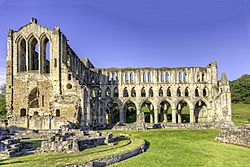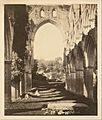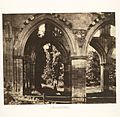Rievaulx Abbey facts for kids
 |
|
| Monastery information | |
|---|---|
| Order | Cistercian |
| Established | 1132 |
| Disestablished | 1538 |
| Mother house | Clairvaux Abbey |
| Diocese | Diocese of York |
| People | |
| Founder(s) | Walter l'Espec and Thurstan, Archbishop of York |
| Important associated figures | Aelred of Rievaulx |
| Site | |
| Location | Rievaulx, North Yorkshire, England |
| Coordinates | 54°15′27″N 1°7′0″W / 54.25750°N 1.11667°W |
| Visible remains | substantial |
| Public access | yes |
Rievaulx Abbey (say it like "ree-VOH") was a very important monastery in North Yorkshire, England. It was home to Cistercian monks. Monasteries are places where monks or nuns live together, dedicating their lives to prayer and work.
Rievaulx Abbey was built in 1132 near Helmsley, in the beautiful North York Moors National Park. It grew to be one of the biggest and richest abbeys in England. However, in 1538, King Henry VIII closed it down during a time called the dissolution of the monasteries.
Today, the amazing ruins of Rievaulx Abbey are a popular tourist spot. They are looked after by English Heritage, an organization that cares for historic places.
Contents
Starting the Abbey
A New Home for Monks
Rievaulx Abbey was the first Cistercian monastery built in the north of England. It was started in 1132 by twelve monks. They came all the way from Clairvaux Abbey in France.
The monks chose this quiet, remote spot for a good reason. The Cistercian order believed in a simple life. They wanted to focus on prayer and be self-sufficient. This meant they would grow their own food and make what they needed. They also wanted to have little contact with the outside world.
Building a Community
A man named Walter Espec helped the monks set up the abbey. He also helped start another Cistercian community in Bedfordshire.
The first leader, or abbot, of Rievaulx was William I. He began building the abbey in the 1130s. The second abbot, Aelred of Rievaulx, helped the abbey grow even more. Under his leadership, Rievaulx became one of the most famous Cistercian abbeys in Yorkshire.
It was almost as well-known as Fountains Abbey. During Aelred's time, the abbey had about 140 monks. It also had 500 lay brothers. Lay brothers were people who lived at the abbey and did manual labor. Rievaulx Abbey even started five new daughter-houses in England and Scotland.
Life and Wealth at the Abbey
Smart Monks and Big Business
Rievaulx Abbey is located in a lovely wooded valley. The River Rye flows nearby. The monks were very clever engineers. They moved parts of the river several times. This gave them enough flat land to build their abbey. You can still see the old river course today.
The monks were also good at business. They mined lead and iron. They also raised many sheep. They sold the wool from their sheep to buyers all over Europe. This made Rievaulx Abbey one of the richest abbeys in England. It owned a lot of land, about 6,000 acres!
Challenges and Changes
By the late 1200s, the abbey started to have money problems. They had spent a lot on building projects. They also lost money because of a sheep disease. Things got worse when raiders from Scotland attacked in the early 1300s.
Then, in the mid-1300s, the terrible Black Death arrived. This disease greatly reduced the population. It became very hard to find new lay brothers to do the manual work. Because of this, the abbey had to rent out much of its land. By 1381, there were only 14 monks and 3 lay brothers left. Some of the abbey buildings were even made smaller.
By the 1400s, the monks' lives became more relaxed. They had once followed very strict rules. But now, they were allowed to eat meat. They also had more private living spaces. The abbot even had his own large household.
The Abbey's End
King Henry VIII's Decision
In the 1530s, King Henry VIII decided to close down all the monasteries in England. This was called the Dissolution of the Monasteries. Rievaulx Abbey was one of the places affected.
At the time it closed in 1538, the abbey had 72 buildings. There was an abbot and 21 monks living there. They also had 102 other employees. The abbey was making a good income each year. It even had a special furnace that made iron very efficiently.
What Happened Next
When the abbey was closed, its buildings were made unusable. All valuable items, like lead from the roofs, were taken away. The land was given to Thomas Manners, 1st Earl of Rutland. He was one of King Henry's advisors. Later, the land passed to the Duncombe family.
After the Monks Left
New Uses for the Land
In the late 1500s and 1600s, Rievaulx became an important place for making iron.
In the 1750s, the owner, Thomas Duncombe III, made his estate more beautiful. He built a special terraced walk. From this walk, people could enjoy amazing views of the abbey ruins and the surrounding landscape. The walk includes two Grecian-style temples. These temples are now cared for by the National Trust. The abbey ruins themselves are still looked after by English Heritage.
In the 20th century, Rievaulx Abbey became a popular historic site. It is still managed by the English Heritage Trust today.
A Famous Name
In 1983, a former prime minister of the UK, Harold Wilson, was given a special honor. He was from Yorkshire. He chose the title "Baron Wilson of Rievaulx." This shows how important Rievaulx is to the area's history.
Burials
Some important people were buried at Rievaulx Abbey:
- Aelred of Rievaulx
- Thomas de Ros, 4th Baron de Ros
- John de Ros, 5th Baron de Ros
Images for kids
-
Ruins of Rievaulx Abbey, painted in 1803 by John Sell Cotman
-
Ruins of Rievaulx Abbey nave, photographed in 1854 by Roger Fenton










